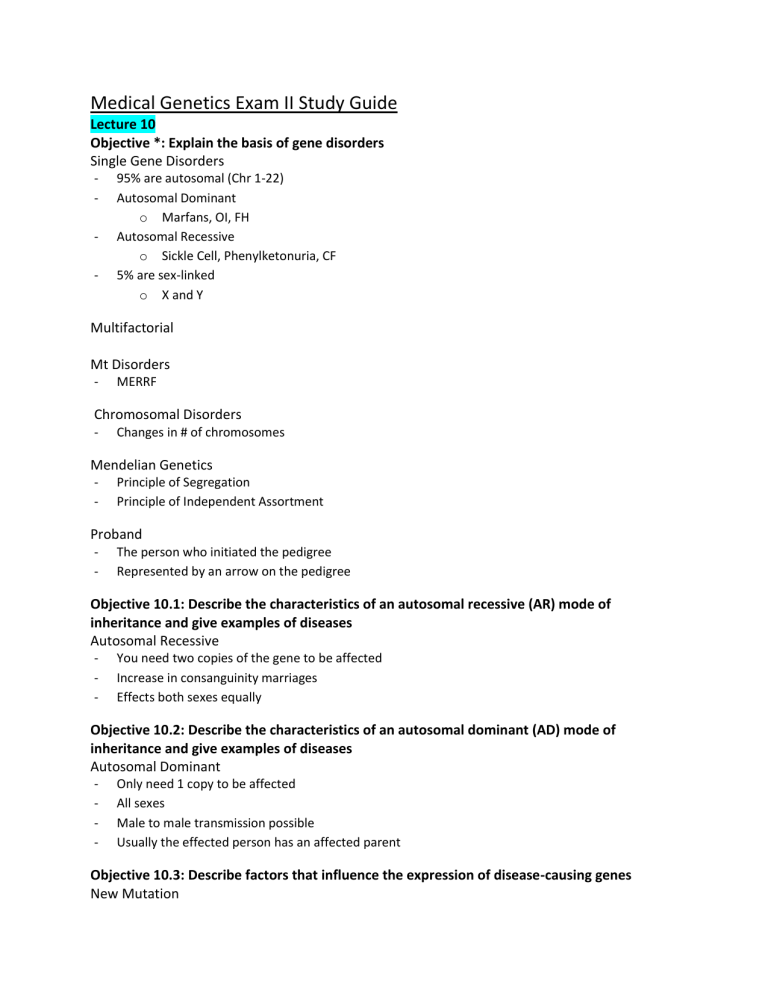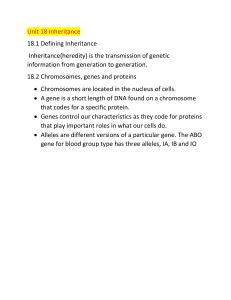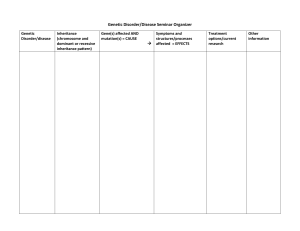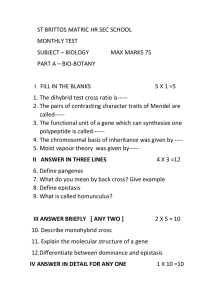
Medical Genetics Exam II Study Guide Lecture 10 Objective *: Explain the basis of gene disorders Single Gene Disorders - 95% are autosomal (Chr 1-22) Autosomal Dominant o Marfans, OI, FH Autosomal Recessive o Sickle Cell, Phenylketonuria, CF 5% are sex-linked o X and Y Multifactorial Mt Disorders - MERRF Chromosomal Disorders - Changes in # of chromosomes Mendelian Genetics - Principle of Segregation Principle of Independent Assortment Proband - The person who initiated the pedigree Represented by an arrow on the pedigree Objective 10.1: Describe the characteristics of an autosomal recessive (AR) mode of inheritance and give examples of diseases Autosomal Recessive - You need two copies of the gene to be affected Increase in consanguinity marriages Effects both sexes equally Objective 10.2: Describe the characteristics of an autosomal dominant (AD) mode of inheritance and give examples of diseases Autosomal Dominant - Only need 1 copy to be affected All sexes Male to male transmission possible Usually the effected person has an affected parent Objective 10.3: Describe factors that influence the expression of disease-causing genes New Mutation - The effected person is the first in the family Ex: Achondroplasia o 75-88% are new mutations o FGFR3 gene on chromosome 4 o Short limbs Delayed Onset - Doesn’t manifest until later in life Ex: Huntington Disease o Triplet nucleotide expansion o Onset: 35-44 yo Penetrance - Sometimes a reduced penetrance which Is an affected genotype that doesn’t manifest the phenotype Ex: Huntington Disease o Individuals with 36-39 repeats have reduced penetrance o More than 40 repeats and its early onset (anticipation) Pleiotropy - Mutation in one gene effects multiple organ systems Ex: o Marfan’s (FBN1 gene) o Phenylketonuria (PAH mutation) Locus heterogeneity - Same phenotype caused by different gene mutations Ex: NHPCC Allelic heterogeneity - Several mutations in the same gene can cause the disease phenotype Ex: beta-thalassemia and CF Phenotypic Heterogeneity: Variable Expressivity - Considerable variation in the severity Ex: Polyaxial Polydactyly o Skin tags or fully formed extra digits Objective 10.4: Understand the rules governing the probability of inheriting a single gene disorder Objective 10.5: Determine AR/AD mode of inheritance from a given pedigree and calculate inheritance/recurrence risk Probability - - Only one copy from each parent is inherited Multiplication Rule (AND Events) o The chance that independent events occur together is the product of their separate probabilities Addition Rule (OR Events) o The chance that one OR another event will occur is the sum of their separate probabilities Lecture 11 Objective 11.1: Describe the role of SRY gene on Y chromosome SRY (Sex Determining Region of Y) - In presence of this gene in Y-chromosome the testes develop - AZF gene: USP9Y, DDX3Y, and DAZ genes o Important for spermatogenesis - Crossing over occurs between X and Y chromosomes o Sometimes the SRY genes cross over to the X and vise versa (XX-males, and XY females) Y-Linked Disorders - Usually makes males infertile so you cannot pass it on If inherited its exclusively male to male transmission Objective 11.2: Describe the characteristics of X-linked recessive mode of inheritance and give examples of diseases X-Linked Recessive - Manifesting Heterozygotes o A carrier with some symptoms o Mosaic because of x-inactivation - Ex: o OTC Mutation o Hemophilia A (Factor VIII gene – British Royal Family – Queen Victoria) - No male to male transmission Objective 11.3: Describe the characteristics of X-linked dominant mode of inheritance and give examples of diseases X-Linked Dominant - If father is affected, all daughters affected and no sons affected - No male to male transmission - Effects more females, but less severity - In all generations - Ex: Fragile-X Syndrome o Repeats in FMR1 gene 5’-UTR o >200 repeats o Most common inherited mental retardation in males o Can diagnose with karyotyping - Ex: Rett Syndrome: Males die in utero Objective 11.4: Describe the characteristics of mitochondrial inheritance and give examples of diseases Mt Diseases - Maternal inheritance pattern - Each cell can contain both normal and mutated mtDNA population o Called threshold effect - Affected mother will transfer to all children - Affected male will not transfer to any children Objective 11.5: Determine the mode of inheritance (Autosomal, X-linked, Y-linked, mitochondrial) from a given pedigree and calculate inheritance/recurrence risk Lecture 12 Objective 12.1: Define complex diseases Complex Diseases - - Common diseases with complex inheritance Tends to cluster in families (but low recurrent risk) Polygenic (multiple genes) o Each gene has a small contribution to the phenotype Multifactorial o Genes and environment Congenital Malformations o Cleft lips/palate o Congenital heart defects o Pyloric Stenosis o Neural tube defects Adult Onset Disorders - o Diabetes Mellitus Type 2 o Alzheimer Disease o Arthritis, Asthma, Cancer Threshold Model o There is a threshold above which a person will develop the multifactorial disorder Objective 12.2: Explain differences between single gene diseases and complex diseases Objective 12.3: Define concordance and explain its use in distinguishing between genetic and environmental influences Adoption Study - Same genetic background, different environment Increase in frequency in adoptive family = environment Increase in frequency in biological family = genetic Population/Migration Study - Prevalence of disease in population groups Can show role of genetics in complex disease because ethnic groups share disease incidences Can show environmental influences because of migration changing disease incidences Family Relationship - 1st Degree o 50% genes in common nd 2 Degree o 25% genes in common rd 3 Degree o 12.5% genes in common Relative Risk Ratio (lambda) 𝐿𝑎𝑚𝑑𝑏𝑎 = - 𝑃𝑟𝑒𝑣𝑎𝑙𝑒𝑛𝑐𝑒 𝑖𝑛 𝑅𝑒𝑙𝑎𝑡𝑖𝑣𝑒𝑠 𝑜𝑓 𝑎𝑛 𝑎𝑓𝑓𝑒𝑐𝑡𝑒𝑑 𝑝𝑒𝑟𝑠𝑜𝑛 𝑃𝑟𝑒𝑣𝑎𝑙𝑒𝑛𝑐𝑒 𝑖𝑛 𝐺𝑒𝑛𝑒𝑟𝑎𝑙 𝑃𝑜𝑝𝑢𝑙𝑎𝑡𝑖𝑜𝑛 If r >1, more likely risk If r = 1 = general population risk s = same, but for siblings o s = 150 for autism Twin Study - Concordance o When two individuals in a family share a trait or have the same disease Concordance Rate o Proportion of pairs of individuals (twins) who share a trait or have the same disease MZ twins share genes and environment - - DZ twins share 50% genes and environment 100% concordance in MZ twins shows strong evidence for genetic link for disease o Ex: Sickle Cell <100% concordance in DZ twins show strong evidence for environmental link of disease MZ twins reared apart o High Concordance = genetic o Low Concordance = Environmental When MZ concordance > DZ concordance, the genetics play a larger role When MZ concordance + DZ concordance is low, the environment plays a larger role Lecture 13 Objective 13.1: Describe the principles of genetic linkage analysis and genome wide association studies (GWAS) Genetic Linkage Analysis - - Linkage o The tendency of genes (or genetic material) at different loci in the same chromosome to be inherited together Use DNA polymorphisms as genetic markers o Ex: Microsatellites, STR, VNTR Used for rare and single gene disorders Family based using a pedigree Only can map to a specific region of the chromosome Find out what genes are in that location and choose a candidate gene Then find gene mutation using targeted exome sequencing Recombination - The frequency of recombination () is a measure of the distance between two loci Further apart are more likely to recombine Closer together are less likely to recombine = 0-0.5 1% recombination = 1Mb (1x106 bp) apart Genetic Association Analysis - Population based Genome wide associated study Calculate Logarithm of Odds (LOD) Scores - - Statistical estimate of whether 2 gene loci are located near each other 𝐿𝑖𝑘𝑒𝑙𝑖ℎ𝑜𝑜𝑑 𝑜𝑓 𝑡ℎ𝑒 𝑑𝑎𝑡𝑎 𝑖𝑓 𝑙𝑜𝑐𝑖 𝑙𝑖𝑛𝑘𝑒𝑑 𝐿𝑂𝐷 = log 𝐿𝑖𝑘𝑒𝑙𝑖ℎ𝑜𝑜𝑑 𝑜𝑓 𝑡ℎ𝑒 𝑑𝑎𝑡𝑎 𝑖𝑓 𝑙𝑜𝑐𝑖 𝑢𝑛𝑙𝑖𝑛𝑘𝑒𝑑 LOD >3 means significant linkage LOD <3 but positive for a family o Supports linkage within that family - o LOD scores are additive between families for the same gene and loci LOD <-2 excludes linkage Genome-Wide Association Studies - - Used for complex disorders Population based Use DNA microarray o Identify SNPs associated with susceptibility to certain diseases o SNPs association with disease have higher frequencies of occurrence in individuals with the disease Plotted on Manhattan Plot Objective 13.2: Explain how genetics linkage analysis are used to identify genes contributing to a particular disease Objective 13.3: Explain how SNPs identified in GWAS may contribute to the development of a particular disease - - >90% of associated SNPs are within non-coding regions Expression Quantitative Trait Loci (eQTL) o SNPs that influence expression (amount) o Effect DNA methylation at promotors Coding SNPs o Non-Synonymous Change AA Truncated protein o Synonymous May effect rate of protein translation or folding Objective 13.4: Compare the strengths and limitations of genetics linkage analysis and GWAS Objective 13.5: Describe the use of GWAS in identifying susceptibility alleles for the following complex diseases: Diabetes mellitus type 1 - Over 60 SNP variants associated with increased risk INS will effect beta cell insulin expression PTPN22 will affect protein tyrosine phosphatase causing beta cell lysis IFIH1 encodes for MDAS protein which will activate autoantibodies Diabetes mellitus type 2 - Over 143 SNP variants TCF7L2 encodes TF for glucagon expression o Likely to fail sulfonylurea therapy SLC30A8 encodes for beta cell zinc transporter - o Causes insulin secretion defect GCK causes increased fasting glucose levels Alzheimer disease - Over 20 SNP variants APOE variants cause risk increases (35-45% of AD patients have this) ADAM10 regulates amyloid precursor proteins (variants make these processes not work) CLU inhibit the formation of amyloid fibrils (variants make these processes not work)





